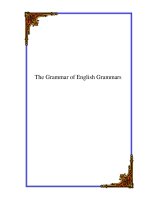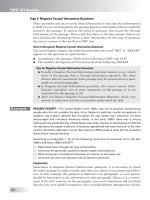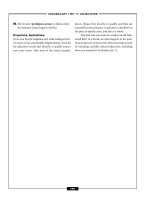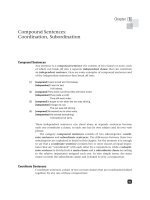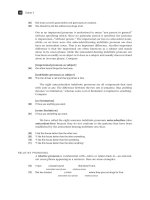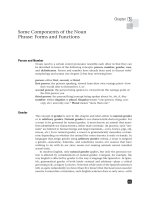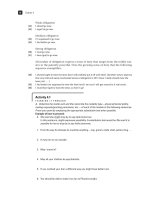Analyzing the Grammar of English Third Edition phần 8 doc
Bạn đang xem bản rút gọn của tài liệu. Xem và tải ngay bản đầy đủ của tài liệu tại đây (223.53 KB, 21 trang )
Chapter 6
162
1. I found the girl who had been to Siberia.
2. He knows the librarian who was killed by a flying book.
3. They wanted to see the dog that you had found.
4. The air which we breathe is full of dust.
5. My wife gave the old lady who you had told me about the money.
6. Last night I finally understood the theory that we had studied.
7. War and Peace is the novel that I’m reading right now.
8. The author to whom you spoke is none other than Philip Roth himself.
9. I told the little girl that the old man gave the candy to not to cry.
10. I want to know the issue that we will be discussing today.
11. The cat that escaped from the basement just had kittens.
12. The question that concerns us today is: should the beggar to whom you gave your life’s
savings return them?
143-170.Teschner.06.indd 162143-170.Teschner.06.indd 162 4/2/07 6:14:54 PM4/2/07 6:14:54 PM
163
13. We sold the gun to the assassin who paid the highest price.
14. That that that that that modifies is misplaced in that phrase.
B. Find the gaps and reinstate the deleted relative pronouns. In some instances, no relative
pronoun has been deleted.
Example of how to proceed:
X. The woman the dog fetched the ball for just loves him to death. “The woman that the
dog fetched the ball for just loves him to death.”
1. The dog I gave the bone to wagged its tail.
2. She wants her to find the thief she was talking about.
3. The con artist who you saw cheat the poor old man has vanished into thin air.
4. I found the money the thief the police captured had hidden.
5. I know the basement he hid it in and the exact minute he hid it.
6. The issue you are referring to has already been dealt with.
7. We gave the boy who won the race a silver dollar.
8. The ghastly ghost I lent my body to said subsequently that I was the man he had picked
for further multitudinous nocturnal escapades.
C. Each of the following sentences contains at least one instance of ungrammaticality or of
stigmatized language. First correct it, and then explain why you have done so, citing rules.
Example of how to proceed:
X. *The man says he’s beyond the law was arrested again for larceny. “The grammati-
cal version of this sentence, which contains two clauses, is The man who/that says
he’s beyond the law was arrested again for larceny. The two clauses are The man
was arrested again for larceny and [the man] says he’s beyond the law. The second of
these is a relative clause. The bracket-marked gap that appears at the beginning of the
second clause is home to the subject of that clause; therefore, it must be filled with a
relative pronoun, because only objects can be gapped.”
1. *The boss to that I am supposed to report is sick today.
2. *A woman whom I must speak has left the office.
3. *Where is the clerk to who I was told to give this message?
The Twenty Types of Relative Clauses
143-170.Teschner.06.indd 163143-170.Teschner.06.indd 163 4/2/07 6:14:55 PM4/2/07 6:14:55 PM
Chapter 6
164
4. *There’s the man what I want to see.
5. *Someone who’s money I stole wants it back.
6. *Who’s the little kid which says he’s lost?
7. *I never did locate the loan shark I wanted to pay him back the money.
8. *He sold the diamonds to the thief whom was going to give them to his wife on her
birthday.
D. Identify all relative clauses and then deconstruct the relativized sentences into their two
component clauses.
Example of how to proceed:
X. Josh is the media superstar I’m going out with. “The relative clause is [who/that] I’m
going out with. Deconstructed into its two component clauses, this sentence now reads:
Josh is a media superstar. I’m going out with Josh.”
1. I will soon be talking with the young woman to whom I awarded the presidential
scholarship.
2. He’s currently writing to the prisoner you told me about.
3. The cat that ate the rat is fat.
4. She told the lawyer you hired a lie.
5. Connie is the student Tom talks about most.
6. They will send the boy they gave their address to an iPod.
7. They will send an iPod to the boy to whom they gave their address.
8. Sam is the math teacher who loves opera.
143-170.Teschner.06.indd 164143-170.Teschner.06.indd 164 4/2/07 6:14:57 PM4/2/07 6:14:57 PM
165
9. You just saw the man who shot JFK.
10. He gave the rabid dog you were looking for a shot.
WRITING IT OUT
E. Write one sentence using each of these words as relative pronouns.
1. whom
2. which
3. that
4. who
5. where
6. why
Restrictive and Nonrestrictive (Relative) Clauses
Compare the following two sentences:
[100] The dogs who were in the kennel barked all night.
restrictive clause
[101] The dogs, who were in the kennel, barked all night.
nonrestrictive clause
The relative clause in (100) is termed restrictive because it restricts or limits
its noun antecedent—the dogs—to one certain set of dogs only and implicitly
contrasts those dogs to all others. (Sentence [100]’s dogs, then, are divisible into
two sets: Those that were in the kennel, and those that were not.) The relative
clause in (101) is termed nonrestrictive because it does not limit or restrict its
antecedent; instead, the information about the kennel is after the fact, offhand,
ancillary, almost an afterthought.
Nonrestrictive relative clauses are always set off by commas. Restrictive clauses
never are.
Restrictive clauses occupy all the cases that are set forth in figure 6b, while
nonrestrictive clauses’ relative pronouns largely function as subjects. However,
English frequently employs the relative pronoun which in three nonrestrictive
clause types as pro-words. Here are the three types:
1. adjective clause
Here, the relative pro-word (pro-adjective) shares coreferentiality with an
adjective that appears in the sentence’s main clause. Examples:
[102] He’s miserable, which I don’t think you are.
Restrictive and Nonrestrictive (Relative) Clauses
143-170.Teschner.06.indd 165143-170.Teschner.06.indd 165 4/2/07 6:14:57 PM4/2/07 6:14:57 PM
Chapter 6
166
Deconstruction
He’s miserable.
I don’t think you are miserable. →→
I don’t think you are which →→
which I don’t think you are →→
He’s miserable, which I don’t think you are.
[103] The peasants’ life is wretched, which yours certainly is not.
Deconstruction
The peasants’ life is wretched.
Yours certainly is not wretched.
Yours certainly is not which
which yours certainly is not
The peasants’ life is wretched, which yours certainly is not.
2. verb clause
Here the pro-verb relativizer (which) enjoys coreferentiality with the verb
phrase of the main clause. Examples:
[104] Zack placed dozens of explicit ads in the personals column, which I could never do.
Deconstruction
Zack placed dozens of explicit ads in the personals column.
I could never place dozens of explicit ads in the personals column. →→
I could never which →→
which I could never do →→
Zack placed dozens of explicit ads in the personals column, which I could
never do.
[105] She tried to jump from one building to the next, which I didn’t.
Deconstruction
She tried to jump from one building to the next.
I didn’t try to jump from one building to the next. →→
I didn’t which →→
which I didn’t →→
She tried to jump from one building to the next, which I didn’t.
3. sentence clause
The pro-sentence relative which is coreferential with the entire main clause
of the relativized sentence, as the following examples will show:
[106] My brother got drunk and stayed out late, which angered my father.
(Note that which corefers neither to night nor brother nor got drunk nor stayed out
late, but to a combination of all these elements together.)
143-170.Teschner.06.indd 166143-170.Teschner.06.indd 166 4/2/07 6:14:59 PM4/2/07 6:14:59 PM
167
Deconstruction
My brother got drunk and stayed out late.
That my brother got drunk and stayed out late angered my father. →→
which angered my father →→
My brother got drunk and stayed out late, which angered my father.
[107] Several large muddy Dalmatians galloped through the cozy little café, which completely ruined the
intimate tea party taking place there.
Deconstruction:
Several large muddy Dalmatians galloped . . .
That several large muddy Dalmatians galloped through the cozy little café com-
pletely ruined the intimate tea party →→
Which completely ruined the intimate tea party →→
Several large muddy Dalmatians galloped through the cozy little café, which
completely ruined the intimate tea party taking place there.
Activity 6.5
THINKING IT THROUGH
A. Label each of the following sentences as restrictive clause or nonrestrictive clause. Then
explain your choice.
1. The Dalmatians, which spent the morning rolling in the mud, couldn’t wait to disrupt the
intimate little tea party.
2. The dachshunds which were kept inside the house did not run across the road and get
killed by cars.
3. The dachshunds, which were kept inside the house, did not run across the road and get
killed by cars.
4. The computers which were regularly upgraded didn’t crash.
5. The computers, which were regularly upgraded, didn’t crash.
B. Tell whether the following nonrestrictive clause sentences contain adjective phrase pro-
forms, verb clause pro-forms, or sentence clause pro-forms. Be sure to identify antecedents
and pro-forms in every instance.
1. Great-Aunt Fannie regularly gossiped about all the neighbors, which was a source of
constant delight for us all.
2. I am very happy, which my friends are too.
Restrictive and Nonrestrictive (Relative) Clauses
143-170.Teschner.06.indd 167143-170.Teschner.06.indd 167 4/2/07 6:15:01 PM4/2/07 6:15:01 PM
Chapter 6
168
3. They are just tickled pink over the birth of their new baby girl, which we are as well.
4. The queen’s consort has left her, which makes her very sad.
5. The baby screamed and screamed, which drove me crazy.
6. Bruce quickly climbed to the top of the mountain, which I didn’t have the energy to attempt.
WRITING IT OUT
C. Write three pairs of restrictive clause/nonrestrictive clause sentences. Then explain the
difference in meaning between each pair.
1. a.
b.
2. a.
b.
3. a.
b.
Relative Pronoun Clauses with Present Participles/Gerunds and with Past Participles
Both types of pronoun clauses involve the creation of a gap. In each instance, the
gap is created at the start of the phrase by deleting (1) the relative pronoun itself,
and (2) the tense-marked form of the verb BE. What remains is the participle
(present or past) and the LV. Here are several examples:
Present participle relative pronoun clause
[108] The check that was being cashed bore my signature.
relative pronoun clause:
antecedent noun relative pronoun tense-marked form of BE present participle LV
Deletion to create gap: The check [ ] being cashed bore my signature.
[109] Give special treatment to victims who are undergoing surgery.
Deletion to create gap: Give special treatment to victims [ ] undergoing surgery.
[110] All foreign debts which are currently being discussed will be extended.
Deletion to create gap: All foreign debts [ ] currently being discussed will be extended.
143-170.Teschner.06.indd 168143-170.Teschner.06.indd 168 4/2/07 6:15:02 PM4/2/07 6:15:02 PM
169
[111] Any student who was smoking in the restroom was expelled instantly.
Deletion to create gap: Any student [ ] smoking in the restroom was expelled instantly.
Past participle relative pronoun phrase
[112] The child who was killed by the bullet was only four.
antecedent noun relative pronoun tense-marked form of BE past participle of LV
Deletion to create gap: The child [ ] killed by the bullet was only four.
[113] It’s impossible to estimate the total amount of money which is stolen by organized crime.
Deletion to create gap: It’s impossible to estimate the total amount of money [ ] stolen by organized crime.
[114] The ship that was sunk by torpedoes now lies below.
Deletion to create gap: The ship [ ] sunk by torpedoes now lies below.
Activity 6.6
THINKING IT THROUGH
A. Reinstate the deleted relative pronouns and the tense-bearing BE forms.
1. All dog owners recently bitten by their pets must report to the hospital immediately.
2. The six sick Sikhs soundly sleeping in the sanitarium suddenly sought safety Saturday.
3. Henry mastered four dead languages spoken several millennia ago in the eastern
Mediterranean.
4. The man murdered by the Mafia managed to mail a message to his Miami mother Mon-
day morning.
5. I’ll never forget those happy childhood scenes of kids playing hide and go seek on a
warm summer’s evening.
6. Now is the time for all good men bled dry by the tax department to rise up in outraged
protest.
WRITING IT OUT
B. Write four pairs of sentences the second of which deletes the relative pronoun and the
tense-marked BE form but the first of which does not. Make sure that two of your sentences
involve present participles and that two of them involve past participles.
1. a.
b.
2. a.
b.
Relative Pronoun Clauses with Present Participles/Gerunds and with Past Participles
143-170.Teschner.06.indd 169143-170.Teschner.06.indd 169 4/2/07 6:15:04 PM4/2/07 6:15:04 PM
Chapter 6
170
3. a.
b.
4. a.
b.
C. Fill in the blanks with any LV present/past participle that makes sense.
Example of how to proceed:
X. The cat being tortured bit her torturer on the wrist.
X. A donkey beaten by its owner eventually takes revenge.
1. The nasty young boy kicked his dentist in the shin.
2. Nine old queens of their boring lives left town immediately.
3. A tiger in a zoo has ways of getting back at its keeper.
4. Executives by their bosses quickly lose their cutting edge.
5. Taxpayers by their elected representatives eventually revolt.
6. Professors at their students have means at their disposal.
Notes
1. Strictly speaking, when, where, and why are relative adverbs, not relative pronouns,
but since the way all seven forms function is not dissimilar, we allow ourselves this
oversimplification.
2. Certain lects do allow the deletion of relative pronouns that constitute the subjects
of their relative clauses, as in the following: The guy [ ] saw me yesterday owes me
twenty grand. But this usage is highly stigmatized.
143-170.Teschner.06.indd 170143-170.Teschner.06.indd 170 4/2/07 6:15:05 PM4/2/07 6:15:05 PM
171
Chapter
7
Adverbs, It and There Referentials and
Nonreferentials, and Fronting
Adverbs
There are four major categories of adverbs, a part of speech that grade school
textbooks once defined in a flawed and incomplete fashion as “words ending
in -ly that modify verbs, adjectives, or other adverbs.” The problem with this
definition is that not all words ending in -ly are adverbs—for example the adjec-
tive ugly—and not all adverbs end in -ly—for example, tomorrow (I will see him
tomorrow), hard (I will work hard), and soon (The job will be done soon). Neverthe-
less, “-ly = adverb” is still a good place to begin a more sophisticated study of the
adverb phenomenon.
The four major categories of adverbs are:
Manner adverbs (which typically modify verbs)
Manner adverbs always lend themselves to the following paraphrase/restate-
ment: (VERB) in an XXXX manner/way/sense. Here are several examples:
[1] Casimir walked slowly up the hill. (Paraphrase: walked in a slow manner)
[2] Gertrude happily cried herself to sleep. (Paraphrase: cried in a happy manner)
[3] The sheep grazed in the meadow lazily. (Paraphrase: grazed in a lazy manner)
[4] We literally ran out of gas. (Paraphrase: ran out of gas in a literal sense)
Gradational adverbs (which typically modify adjectives or other adverbs)
Gradational adverbs (also called intensifiers) answer the question: To what
degree of intensity? Gradational brings to mind a measuring scale and its degrees.
Consider the following sentences:
[5] Anne-Marie is very happy. (Question: To what degree is Anne-Marie happy: extremely happy,
slightly happy, sort of happy, very happy . . . ?)
[6] Jean-Pierre was somewhat glad to see us. (Question: To what degree was Jean-Pierre glad to see
us: to a moderate degree (somewhat), to an extreme degree (tremendously) . . . ?)
Since gradational adverbs typically modify adjectives or other adverbs, another
way to prove whether a given adverb is gradational is to ask: Does the clause
in which it appears contain another adverb? an adjective? If so, then does the
suspected gradational adverb say something about the degree of that adjective
or other adverb?
171-182.Teschner.07.indd 171171-182.Teschner.07.indd 171 4/2/07 6:10:27 PM4/2/07 6:10:27 PM
Chapter 7
172
Standpoint adverbs
Standpoint adverbs typically modify adjectives but differ from gradational
adverbs in the question they ask. While gradationals ask about degrees on a scale,
standpoints ask about the perspective or standpoint from which something is
viewed. A standpoint paraphrase proves whether a word is a standpoint adverb
or not. Thus:
[7] Your reasoning is logically impossible. (Paraphrase: Your reasoning is impossible from the stand-
point of logic.)
[8] At first, quantum mathematics was viewed as theoretically unlikely. (Paraphrase: At first, quantum
mathematics was viewed as unlikely from the standpoint of [mathematical] theory.)
Let us now prove that a standpoint adverb is neither a manner adverb nor a gra-
dational adverb:
A standpoint adverb submitted to a manner paraphrase: *Your reasoning is
impossible in a logical manner. (This paraphrase makes no sense; something
cannot be impossible in a manner that is logical.)
A standpoint adverb submitted to a gradational paraphrase: Your reasoning is
logically impossible. To what degree [of intensity] is it so? *It is impossible to a
logical degree. (One cannot speak of something being impossible to a logical
degree.)
Sentence adverbs
Sentence adverbs are like sentence clause pro-words in that they are coreferen-
tial with the rest of the sentence they form part of. To prove that something is a
sentence adverb, we make use of a sentence adverb paraphrase, which goes like
this: It is X that Here are some examples of sentence adverbs:
[9] You clearly intend to get drunk tonight. (Paraphrase: It is clear that you intend to get drunk tonight.)
[10] He has evidently had a hard time at work. (Paraphrase: It is evident that he has had a hard time at
work.)
None of the other adverbials’ paraphrases can apply to sentence adverbs (which
proves of course that sentence adverbs are a separate category):
manner: *You intend to get drunk tonight in a clear manner.
gradational: To what degree of intensity do you intend to get drunk?—*To a clear degree.
standpoint: *You intend to get drunk tonight from the standpoint of clear/from the
standpoint of clarity/of clearness.
Adverbs denoting time—a major category in English—are also sentence
adverbs, as the following show:
[11] They arrived late. (Paraphrase: It was late when they arrived.) (Cf. *They arrived in a late manner;
*They arrived to a late degree of intensity; *They arrived from the standpoint of late/lateness.)
[12] The plane will arrive at 5:15 p.m. (Paraphrase: It will be 5:15 p.m. when the plane arrives.)
Adverbs denoting time always answer the question: When? Other questions that
adverbs typically answer are: Where? To what degree? How?
171-182.Teschner.07.indd 172171-182.Teschner.07.indd 172 4/2/07 6:10:29 PM4/2/07 6:10:29 PM
173
Activity 7.1
THINKING IT THROUGH
A. Classify each adverb or adverbial phrase as manner, gradational, standpoint, or sentence.
Then prove your classification through paraphrase or some other test. If an adverb lends
itself to more than one classification, show how that is so.
Example of how to proceed:
X. I am absolutely convinced you do not love me. “Convinced is a predicate adjective modi-
fied by absolutely, which answers the question: To what degree am I convinced you do
not love me? To an absolute degree. Thus absolutely is a gradational adverb.”
1. They are slightly ashamed of what they did.
2. The horses cantered lazily down the road.
3. Such a surgical procedure is medically risky.
4. He has always wanted to be able to run fast.
5. Monkeys obviously love bananas.
6. Monkeys love bananas obviously.
7. We had a totally wonderful time at your party.
8. They certainly like to drink, don’t they?
9. We had planned on leaving at 6:30, but something came up at the last minute.
10. English two-word verbs can be syntactically complicated.
11. Rapidly careening downstream, the canoe slowly began to leak.
12. I’m just moderately tired after doing all this work.
13. Unfortunately every generation has its share of liars, cheats, and psychopaths.
14. We are going to leave now.
Adverbs
171-182.Teschner.07.indd 173171-182.Teschner.07.indd 173 4/2/07 6:10:30 PM4/2/07 6:10:30 PM
Chapter 7
174
WRITING IT OUT
B. Use each of the following adverbs in an original sentence and then name the adverb’s
category.
1. happily
2. obviously
3. totally
4. somewhat
5. tomorrow
6. possessively
7. psychologically
8. radically
9. quickly
10. awfully
11. real
12. kind of
13. obsessively
It as a Referential, It as a Nonreferential
Consider the word it in the following sentence:
[13] Do you remember where I stored my suitcase? It might be in the attic, or it might be in the garage.
In this sentence, it clearly corefers with the singular object noun suitcase; (13)’s it,
then, is a typical 3.sg. DO neuter-gendered pronoun. It and suitcase are therefore
co-referential; consequently, it enjoys referential status. But compare (13) and
how it uses it to the way that (14) uses it:
[14] Do you really think we should go to the beach? It looks like it is going to rain.
In (14), the two it pronouns are obviously not coreferential with beach, as (15)
proves:
[15] *The beach looks like the beach is going to rain.
171-182.Teschner.07.indd 174171-182.Teschner.07.indd 174 4/2/07 6:10:30 PM4/2/07 6:10:30 PM
175
Nor can we claim that (14)’s its are some sort of sentence-level pro-word on the
order of which, what, or the fact that, since the following two sentences do not
pattern alike at all:
Sentence-level pro-word
[16] My brother got drunk and stayed out late is what really made my father mad.
Not a sentence-level pro-word
[17] *Your really thinking we should go to the beach is what looks like it is going to rain.
So where does the it of sentence (14) come from if it cannot constitute a co-
referential of some anterior antecedent appearing in the surface structure? One
explanation of the origin and presence of an it in a sentence like (14) is that
English clauses typically have a surface subject: in almost every clause the subject
slot must be filled by a word that functions as a subject. Therefore, constructions
such as the following are either ungrammatical or strictly elliptical (though if
understood to be elliptical then they are indeed grammatical):
1
[18] Always arrives on time. [ = He/She/It always arrives on time.]
[19] Seems strange he’d know that. [ = It seems strange he’d know that.]
[20] Looks like it is going to rain. [ = It looks like it is going to rain.]
As noted above, the problem with It looks like it is going to rain (14, 20) and sen-
tences like it is they lack any visible surface structure antecedent—noun, clause,
or whole sentence. So in effect, coreferentialities for it have had to be presup-
posed. Several are suggested, among them the weather, the temperature, the climate,
and the environment. Thus it is not too much of a stretch of the imagination to
substitute one of these “weather” coreferentials—in this case the weather—for
both of the its of a sentence like (21), no matter how awkward the final product
appears:
[21] It looks like it is going to rain. = ?The weather looks like the weather is going to rain.
Yet even presuming the weather is coreferential to both its, an equally powerful
explanation—in particular for the presence of (21)’s first it—is simply the need
for every English clause to have a subject. Therefore, both coreferentiality and
the need for a subject explain the its in (14), (20), and (21) as well as many other
English sentences, especially those dealing with the weather.
Adverb Referential There, Existence-Marking Nonreferential There
In general terms, what applies to it (as a referential or as a nonreferential) applies
to there as well. Let us demonstrate the important difference between adverb ref-
erential there and existence-marking nonreferential there:
Adverb referential there
[22] Did you find my racket in the gym? I’m absolutely certain I left it there.
prepositional phrase expressing location pro-prepositional phrase (location)
Adverb Referential There, Existence-Marking Nonreferential There
171-182.Teschner.07.indd 175171-182.Teschner.07.indd 175 4/2/07 6:10:31 PM4/2/07 6:10:31 PM
Chapter 7
176
Existence-marking nonreferential there
[23] Did Edward find my racket in the gym? There is just no other place I could have left it.
prepositional nonreferential noun phrase that
phrase used (not used is used as an
as adverb to to express adverb that
express location location) expresses location
While there in (22) is clearly coreferential with in the gym, there in (23) is not
coreferential with any possible antecedent—not with in the gym, nor racket, nor
you, etc. So (23)’s there is nonreferential. As a nonreferential, this new kind of
there must be given its own name. The name most typically used is existential
there because this type of there is often used to refer to—make note of, point
out—the existence of something, as in the following sentences:
Existential there:
[24] There are many problems to be resolved. [Sentence (24)’s there + BE construction lends itself to
the following existential paraphrase: Many problems exist, and need resolving.]
[25] There is a job for us to do. Existential paraphrase: A job exists for us to do.
[26] There may not be a Santa Claus, but there surely is a Devil. Existential paraphrase: A Santa Claus
may not exist, but a Devil surely does. Note also that the there + BE construction can be inter-
rupted by adverbs (surely), by modals (may), by negatives (not), and even by other verbs (There
just has to be somewhere I can go!).
[27] There will be time enough for that tomorrow. Existential paraphrase: Time enough for that exists
tomorrow.
[28] There is a present for you under the tree. Existential paraphrase: A present for you exists/can be
found under the tree.
[29] There are hundreds of houses in that area, while just four years ago not a single one had been
built. Existential paraphrase: Hundreds of houses exist/are located in that area, while just four
years ago not a single one had been built.
Existential there can also be used in sentences that express events (There are
several elephants running around loose) or states (There are three corpses buried in that
cave). It should be noted as well that several other verbs besides be—verbs such as
stand, dwell, and arise—can appear with nonreferential there to express existence,
location, events, states, etc.:
[30] Nowadays there stands a used car lot where some wetlands used to be.
[31] There dwell several tribes of pygmies in that jungle.
[32] There arose a serious problem, just when we thought we had everything solved.
Activity 7.2
THINKING IT THROUGH
A. Underline and then label all uses of it (referential it, nonreferential it) and there (adverb ref-
erential there, existence-marking nonreferential there). Then prove by means of paraphrase
that each there you classify as existence-marking nonreferential is truly what you say it is.
1. There’s a fly in my soup.
2. Well, finally! After all this searching, there’s the fly in my soup I was telling you about.
171-182.Teschner.07.indd 176171-182.Teschner.07.indd 176 4/2/07 6:10:32 PM4/2/07 6:10:32 PM
177
3. There is where I found it after looking everywhere.
4. It’s a long long way to Tipperary.
5. It’s located a long long way from Tipperary.
6. As long as there are songs to sing, I’ll be loving you.
7. I knew it would start to rain the minute it clouded over.
8. The minute I saw the dragon, I knew it would be breathing fire all over town.
9. He said that there were thousands of rats there.
10. It’s been heard here, and there, and all around the town.
11. Sam told me there was a mouse running around the basement.
12. There just has to be some decency left in the world!
13. It ain’t over ‘til the fat lady sings.
14. Now there’s just no reason in the world why you can’t just stay right there until I finish it.
15. It says right there in the contract that it’s never too late to get your money back.
WRITING IT OUT
B. Write two original sentences corresponding to each description.
1. nonreferential it, weather reference
2. referential there
3. referential it
Adverb Referential There, Existence-Marking Nonreferential There
171-182.Teschner.07.indd 177171-182.Teschner.07.indd 177 4/2/07 6:10:33 PM4/2/07 6:10:33 PM
Chapter 7
178
4. existence-marking nonreferential there
5. existence-marking nonreferential there
6. nonreferential it and existence-marking nonreferential there
7. referential it and referential there
Emphasis by Peak Stressing, Solo Fronting, or Cleft Fronting
Peak stressing
There are several ways to express and assign emphasis (see chapter 3). One way is
by peak stressing the already strong-stressed syllable of the word that you will be
assigning a special emphasis to. Here is an example sentence to practice with:
[33] Jerry murdered his great-grandfather with an axe on Monday.
1 2 3 4 5 6 7
By peak stressing word 1 (Jerry), we drive home the point that it was Jerry and
not someone else who did the deed; by peak stressing 2 (murdered), we assert that
Jerry did not just give Gramps a friendly tap on the head; if 3 is peak stressed, we
make it clear that it was his great-grandfather (and not someone else’s) that he
murdered—and on and on, for a total of seven peak stressable possibilities. As is
its custom, peak stress does one of these two things: it contrasts X with Y or it
emphasizes X (sometimes at Y’s expense.)
Types of fronting: solo fronting, cleft fronting
But there is an entirely different way of expressing emphasis: by fronting any
noun, noun phrase, or noun-containing prepositional phrase that you wish to
emphasize. Fronting means to move the word you want to emphasize to the front
of the sentence. There are two different ways of fronting a word or a phrase:
solo fronting the word/phrase involves no other changes in the word order of
the sentence or in the nature of its constituent elements
cleft fronting (also commonly known as clefting): cleft fronting a word/phrase
does involve word order changes that employ one of these two syntactic
patterns: it-clefting or wh-clefting
Figure 7a uses a tree to sort out the relationships between these ways of express-
ing emphasis. Here are several examples of solo fronting. (Peak-stressed syllables
appear in boldface type with acute accent marks; the solo-fronted element is
underlined in full.)
[34] His great-grándfather Jerry murdered with an axe on Monday.
[35] On Mónday Jerry murdered his great-grandfather with an axe.
[36] With an áxe Jerry murdered his great-grandfather on Monday.
171-182.Teschner.07.indd 178171-182.Teschner.07.indd 178 4/2/07 6:10:34 PM4/2/07 6:10:34 PM
179
And here are several examples of cleft fronting, a complicated process analyzed
in detail once the examples have been presented:
[37a] It was his great-grándfather who Jerry murdered with an axe on Monday.
[37b] Who Jerry murdered with an axe on Monday was his great-grándfather.
[38a] It was on Mónday when Jerry murdered his great-grandfather with an axe.
[38b] When Jerry murdered his great-grandfather with an axe was on Mónday.
[39a] It was with an áxe that Jerry murdered his great-grandfather on Monday.
[39b] What Jerry murdered his great-grandfather with on Monday was an áxe.
As exemplified in (37a) through (39b), cleft fronting follows two distinct syntac-
tic patterns: it-clefting and wh-clefting.
It-clefting
In sentences that utilize it-clefting, the syntactic pattern is this:
it + BE + emphasized item + relative pronoun coreferential to the emphasized
item
The it of an it-clefted sentence is coreferential in a special sense: although it does
not share coreferentiality with any antecedent noun, it is coreferential with the
emphasized noun or phrase that follows BE. Thus it is coreferential with on Mon-
day in (40), with Jerry in (41), and with his great-grandfather in (42). The it-clefted
sentence’s BE often enters into a verb tense (e.g., It was Jerry who . . . ; It would be
Jerry who . . . ; It has always been Jerry who . . . ). Look at these additional examples
of it-clefting:
[40] It was on Monday when Jerry murdered . . .
it BE prep. phrase relative pro-word
[41] It was Jerry who murdered . . .
it BE noun phrase relative pro-word
[42] It was his great-grandfather that Jerry murdered . . .
it BE noun phrase relative pro-word
Wh-clefting
In sentences that utilize wh-clefting, the syntax involves putting the relative pro-
noun (wh-) at the very start of the sentence and the emphasized item at the very
end, thus: wh- + + emphasized item. Here are some examples of wh-clefting:
Emphasis by Peak Stressing, Solo Fronting, or Cleft Fronting
Figure 7a Different Ways of Expressing Emphasis
emphasis
peak stress
fronting
it-clefting
solo fronting cleft fronting
wh-clefting
171-182.Teschner.07.indd 179171-182.Teschner.07.indd 179 4/2/07 6:10:35 PM4/2/07 6:10:35 PM
Chapter 7
180
[43] When Jerry murdered his great-grandfather with an axe was on Monday.
relative pronoun emphasized item
[44] Who murdered his great-grandfather with an axe on Monday was Jerry.
relative pronoun emphasized item
Sentence (44) may sound unnatural; a more natural rewrite might give: The per-
son/The one who murdered his great-grandfather with an axe on Monday was Jerry.
[45] What Jerry murdered his great-grandfather with on Monday was an axe.
relative pronoun emphasized item
Here is the full panoply of clefting (both it- and wh-) for one short sentence:
[46] John gave Marsha the keys.
it-clefting:
John-emphasis:
It was John who gave Marsha the keys.
Marsha-emphasis:
It was Marsha who(m) John gave the keys to.
It was Marsha to whom John gave the keys.
keys-emphasis:
It was the keys that John gave Marsha.
wh-clefting:
John-emphasis:
Who gave Marsha the keys was John.
The person/The one who gave Marsha the keys was John.
Marsha-emphasis:
Who(m) John gave the keys to was Marsha.
keys-emphasis:
What John gave Marsha was the keys.
Verb phrases cannot be fronted: *It was gave that Marsha did to John the keys.
Activity 7.3
THINKING IT THROUGH
A. Tell which of the following sentences involve fronting and which fronting pattern—solo
fronting or cleft fronting—is involved. If the fronting pattern is cleft fronting, tell whether
it is it-clefting or wh-clefting. Next, defront all fronted sentences, returning each one to its
original prefronted syntax.
Example of how to proceed:
X. It was John who threw the glass on the floor. “This sentence involves it-clefting.
Defronted, the sentence reads: ‘John threw the glass on the floor.’”
171-182.Teschner.07.indd 180171-182.Teschner.07.indd 180 4/2/07 6:10:36 PM4/2/07 6:10:36 PM
181
Y. On the floor is where John threw the glass. “This sentence involves wh-clefting.
Defronted, the sentence reads: ‘John threw the glass on the floor.’”
Z. On the floor John threw the glass. “This sentence involves solo fronting. Defronted, the
sentence reads: ‘John threw the glass on the floor.’”
1. Who turned out to be the murderer was Jerry.
2. It was the glass on the floor that bothered John.
3. It was time to go home.
4. The drunk hid the bourbon in the cellar.
5. What bothered John was the glass on the floor.
6. It was the thief who bit the dog, and not vice versa.
7. It was a dark and stormy night, and a fire burned fiercely in the fireplace.
8. Where I’m going is home.
9. Where do you want to go?
10. There is nothing for us to get so upset about.
11. It’s a pencil (and not a pen) that Mary needs to finish her project with.
12. Where he died doesn’t interest me.
13. What doesn’t interest me is where he died.
14. Who she poisoned is who we’re looking for, as this is a case of a murder without a corpse.
15. Who she poisoned has nothing to do with the matter at hand.
Emphasis by Peak Stressing, Solo Fronting, or Cleft Fronting
171-182.Teschner.07.indd 181171-182.Teschner.07.indd 181 4/2/07 6:10:37 PM4/2/07 6:10:37 PM
Chapter 7
182
B. Change each of the following into all possible frontings—solo fronting as well as cleft
fronting (both it-clefting and wh-clefting).
1. Bo stabbed Bea with a knife in the kitchen on Saturday at six after returning from the
library.
2. Ana bought Lynn a new chair with the money from the inheritance.
3. Everyone knows the trouble I’ve seen.
4. The quick brown fox jumped over the lazy sleeping dog.
5. Henry made Joe a peanut butter and jelly sandwich.
6. Uncle Andrew gave him three new Italian sport coats for his birthday.
7. Julia spilled the béarnaise sauce on the floor in front of all the television cameras.
8. I want you to deliver a million dollars in a suitcase to my godfather by tomorrow night.
WRITING IT OUT
C. Unscramble the following words so they form grammatical sentences.
1. glass floor the thrown had John it a on was that
2. time was was bridge Gladdie the what at playing
3. top stove left casserole where the the I of on was
4. John pick who always is it must up after Gladdie
5. bulletin entire scandalized it the by faculty Alberto’s was that was
6. complain the of chair to the went to Ana María immediately department
Note
1. There is one important exception to this rule—the unmarked imperative (Stop
that noise right this very minute!)—a fully grammatical and in no way stigmatized
construction.
171-182.Teschner.07.indd 182171-182.Teschner.07.indd 182 4/2/07 6:10:38 PM4/2/07 6:10:38 PM
